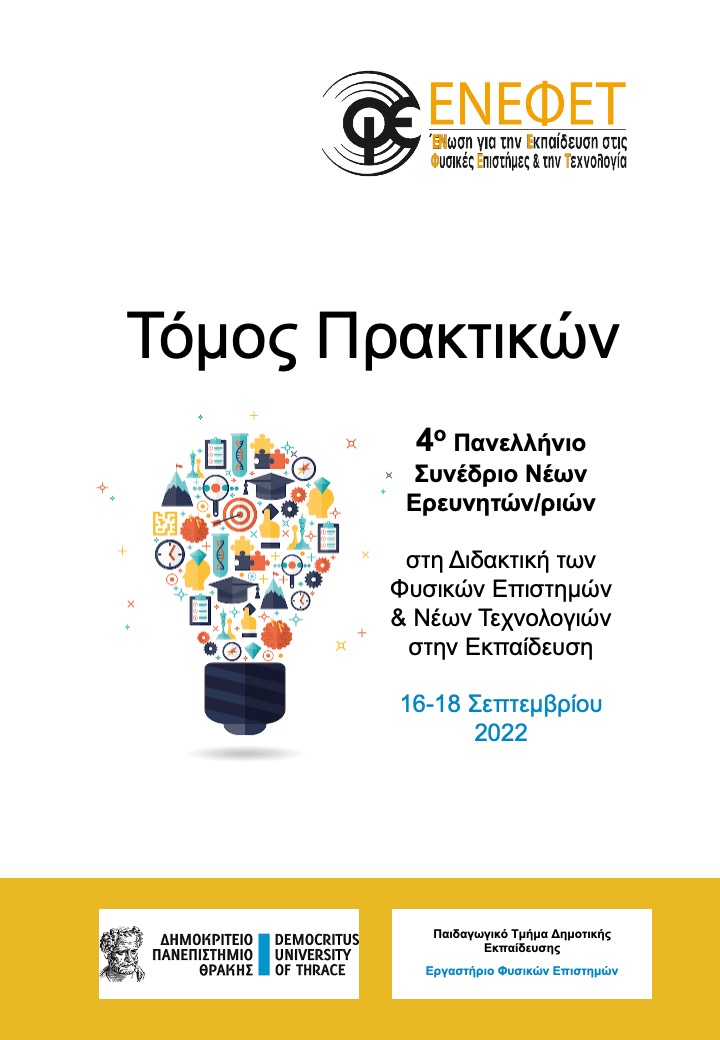Ιδέες και διαδικασίες μάθησης Φοιτητών Τμημάτων Φυσικής και Χημείας πάνω στις εξαρτώμενες από το μέγεθος οπτικές ιδιότητες υλικών στην νανοκλίμακα
Περίληψη
Το καινοτόμο πεδίο της Νανοτεχνολογίας έχει ευρέως καταγεγραμμένη διδακτική αξία σε όλες τις βαθμίδες εκπαίδευσης. Σε αυτήν την εργασία παρουσιάζεται η εφαρμογή μιας διδακτικής ακολουθίας, δομημένη με βάση τις αρχές του Μοντέλου της Διδακτικής Αναδόμησης. Yυλοποιήθηκε με τη μέθοδο του Διδακτικού Πειράματος σχετικά με τις εξαρτώμενες από το μέγεθος ιδιότητες στην νανοκλίμακα, με σκοπό τη διερεύνηση ιδεών και διαδικασιών μάθησης φοιτητών/τριων τμημάτων χημείας και φυσικής. Tα αποτελέσματα έδειξαν μια σειρά αρχικών εναλλακτικών ιδεών καθώς και μία πιθανή διαδικασία υπέρβασης τους μέσω της εισαγωγής της έννοιας του κβαντικού εγκλωβισμού.
Λεπτομέρειες άρθρου
- Ενότητα
- Εργασίες Υποψηφίων Διδακτόρων
Αναφορές
Bhushan, B., Luo,D., Schricker, S., R., Sigmund, W. & Zauscher,S. (2014) Handbook of Nanomaterials, Berlin Heidelberg: Springer. ISBN: 978-3-642-31107-9
Biju, V., Itoh, T., Anas, A., Sujith, A., & Ishikawa, M. (2008). Semiconductor quantum dots and metal nanoparticles: Syntheses, optical properties, and biological applications. Analytical and Bioanalytical Chemistry, 391, 2469–2495. https://doi.org/10.1007/s00216-008-2185-7
Sakhnini,S. & Blonder, R. (2015) Essential concepts of nanoscale science and technology for high school students based on a Delphi study by the expert community. International Journal of Science, 37(11), 1699-1738. https://doi.org/10.1080/09500693.2015.1035687
Schank, P., Wise, A., Stanford, T., & Rosenquist, A. (2009). Can high school students learn nanoscience? An evaluation of the viability and impact of the NanoSense curriculum [Technical Report]. California, US: SRI International.
Stevens, S. Y., Sutherland, L. M., & Krajcik, J. S. (2009). The big ideas of nanoscale science and engineering: A guidebook for secondary teachers. Virginia (USA): National Science Teachers Association. ISBN: 978-1935155072
Stevens, S. Y, Delgado, D, Krajcik J.S. (2010) Developing a Hypothetical Multi-Dimensional Learning Progression for the Nature of Matter, Journal of Research in Science Teaching, 47(6), 687-715. https://doi.org/10.1002/tea.20324
Talanquer, V (2018) Progression in reasoning about structure-property relationships. Chemistry Education Research and Practice,19, 998-1009. https://doi.org/10.1039/C7RP00187H
Mayring P., (2015). Qualitative Content Analysis: Theoretical Background and Procedures. Ιn A. Bikner-Ahsbahs, C. Knipping & N. Presmeg (Eds.), Approaches to Qualitative Research in Mathematics Education (pp. 365-380), Dordrecht: Springer. https://nbn-resolving.org/urn:nbn:de:0168-ssoar-395173
Méheut, M., & Psillos, D. (2004). Teaching–learning sequences: Aims and tools for science education research. International Journal of Science Education, 26(5), 515–535. https://doi.org/10.1080/09500690310001614762
Metaxas, I., Michailidi E., Stavrou, D. & Pavlidis, I., V. (2021). Educational reconstruction of size-dependent properties in nanotechnology for teaching in tertiary education, Chemistry Teacher International, 3(4), 413-422. https://doi.org/10.1515/cti-2021-0011
Duit, R., Gropengießer, H., Kattmann, U., Komorek, M., & Parchmann, I. (2012) The model of educational reconstruction – A framework for improving teaching and learning science. In Science Education Research and Practice in Europe (pp. 13-37). Rotterdam: Sense Publishers. DOI: 10.1007/978-94-6091-900-8_2
Duschl, R., Maeng, S. & Sezen, A. (2011) Learning progression and teaching sequences: a review and analysis, Studies in Science Education, 47(2), 123-182. https://doi.org/10.1080/03057267.2011.604476
Healy, N. (2009) Why nano education? Journal of Nano Education, 1(1), 6-7 DOI:10.1166/jne.2009.004
Hingant, B. & Albe, V. (2010). Nanoscience and nanotechnologies leasrning and teaching in secondary education: a review of literature, Studies in Science Education, 46(2), 121-152. https://doi.org/10.1080/03057267.2010.504543
Jackman, J. A., Cho, D.-J., Jackman, J. S., Sweeney, A. E., & Cho, N.-J. (2020). Training leaders in nanotechnology. In Sattler, K. D. (Ed.), 21st Century nanoscience – A handbook: Public policy, education, and global trends (pp. 5-1–5-12). Boca Raton: CRC Press. ISBN: 9780429351631
Jenkins, J., Wax, T., J. & Zhao, J. (2017). Seed-mediated synthesis of gold nanoparticles of controlled sizes to demonstrate the impact of size on optical properties, Journal of Chemical Education, 94(8), 1090-1093. https://doi.org/10.1021/acs.jchemed.6b00941
Komorek M. & Duit R., (2004). The teaching experiment as a powerful method to develop and evaluate teaching and learning sequences in the domain of non-linear systems. International Journal of Science Education, 26, 619-633. DOI:10.1080/09500690310001614717
Kong, Y., Rodgers, K. J., Diefes-Dux, H., Douglas, K. A. & Madhavan, K. (2014) First-year engineering students' communication of nanotechnology size & scale in a design challenge. Proceedings of the 121st ASEE Annual Conference and Exposition. Indianapolis: American Society for Engineering Education. https://doi.org/10.1002/jee.20172






